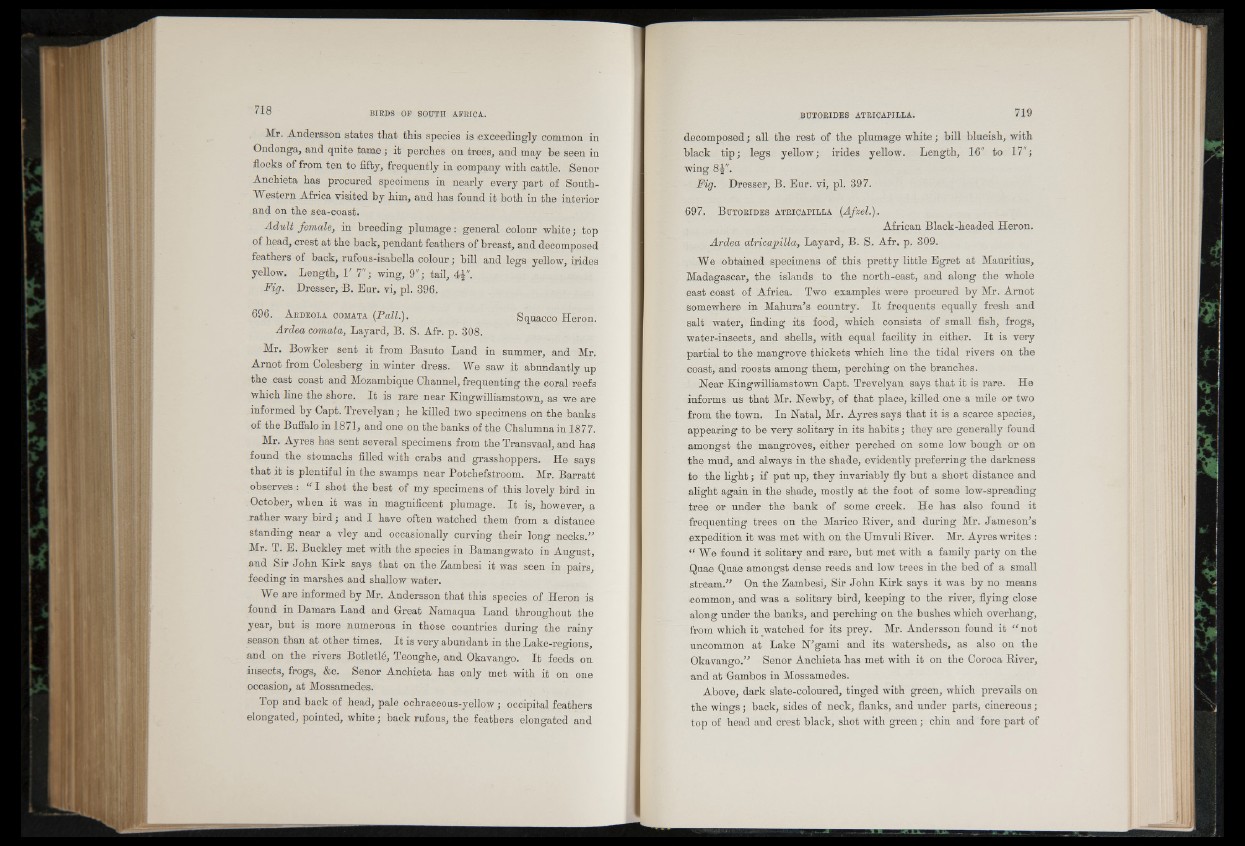
Mr. Andersson states that this species is exceedingly common in
Ondonga, and quite tame; it perches on trees, and may be seen in
flocks of from ten to fifty, frequently in company with oattle. Senor
Anchieta has procured specimens in nearly every part of South-
Western Africa visited by him, and has found it both in the interior
and on the sea-coast.
Adult female, in breeding plumage: general colour white; top
of head, crest at the back, pendant feathers of breast, and decomposed
feathers of back, rufous-isabella colour; bill and legs yellow, irides
yellow. Length, ■!' 7"; wing, 9"; tail, 4f'.
Fig. Dresser, B. Bur. vi, pi. 396,
696. A r d e o l a c o m a t a (P a l l . ) . Squacco Heron.
Ardea comata, Layard, B. S. Afr. p. 308.
Mr. Bowker sent it from Basuto Land in summer, and Mr.
Arnot from Colesberg in winter dress. We saw it abundantly up
the east coast and Mozambique Channel, frequenting the coral reefs
which line the shore. It is rare near Kingwilliamstown, as we are
informed by Capt. Trevelyan ; he killed two specimens on the banks
of the Buffalo in 1871, and one on the banks of the Chalumna in 1877.
Mr. Ayres has sent several specimens from the Transvaal, and has
found the stomachs filled with crabs and grasshoppers. He says
that it is plentiful in the swamps near Potchefstroom. Mr. Barratt
observes: “ I shot the best of my specimens of this lovely bird in
October, when it was in magnificent plumage. It is, however, a
rather wary bird; and I have often watched them from a distance
standing near a vley and occasionally curving their long necks.-”
Mr. T. E. Buckley met with the species in Bamangwato in August,
and Sir John Kirk says that on the Zambesi it was seen in pairs,
feeding in marshes and shallow water.
We are informed by Mr. Andersson that this species of Heron is
found in Damara Land and Great Namaqua Land throughout the
year, but is more numerous in those countries during the rainy
season than at other times. It is very abundant in the Lake-regions,
and on the rivers Botletle, Teoughe, and Okavango. It feeds on
insects, frogs, &c. Senor Anchieta has only met with it on one
occasion, at Mossamedes.
Top and back of head, pale ochraceous-yellow ; occipital feathers
elongated, pointed, white; back rufous, the feathers elongated and
decomposed; all the rest of the plumage white; bill blueish, with
black tip; legs yellow; irides yellow. Length, 16" to 17";
wing 8^".
Fig. Dresser, B. Eur. vi, pi. 397.
697. B u to ride s a tr ica pil la (Afzel.).
African Black-beaded Heron.
Ardea atricapilla, Layard, B. S. Afr. p. 309.
We obtained specimens of this pretty little Egret at Mauritius,
Madagascar, the islands to the north-east, and along the whole
east coast of Afriea. Two examples were procured by Mr. Arnot
somewhere in Mahura’s country. It frequents equally fresh and
salt water, finding its food, which consists of small fish, frogs,
water-insects, and shells, with equal facility in either. It is very
partial to the mangrove thickets which line the tidal rivers on the
coast, and roosts among them, perching on the branches.
Near Kingwilliamstown Gapt. Trevelyan says that it is rare. He
informs us that Mr. Newby, of that place, killed one a mile or two
from the town. In Natal, Mr. Ayres says that it is a scarce species,
appearing to be very solitary in its habits; they are generally found
amongst the mangroves, either perched on some low bough or on
the mud, and always in the shade, evidently preferring the darkness
to the bght; if put up, they invariably fly but a short distance and
alight again in the shade, mostly at the foot of some low-spreading
tree or under the bank of some creek. He has also found it
frequenting trees on the Marico River, and during Mr. Jameson’s
expedition it was met with on the Umvuli River. Mr. Ayres writes :
“ We found it sobtary and rare, but met with a family party on the
Quae Quae amongst dense reeds and low trees in the bed of a small
stream.” On the Zambesi, Sir John Kirk says it was by no means
common, and was a solitary bird, keeping to the river, flying close
along under the banks, and perching on the bushes which overhang,
from which it watched for its prey. Mr. Andersson found it “ not
uncommon at Lake N’gami and its watersheds, as also on the
Okavango.” Senor Anchieta has met with it on the Coroca River,
and at Gambos in Mossamedes.
Above, dark slate-coloured, tinged with green, which prevails on
the wings; back, sides of neck, flanks, and under parts, cinereous;
top of head and crest black, shot with green; chin and fore part of